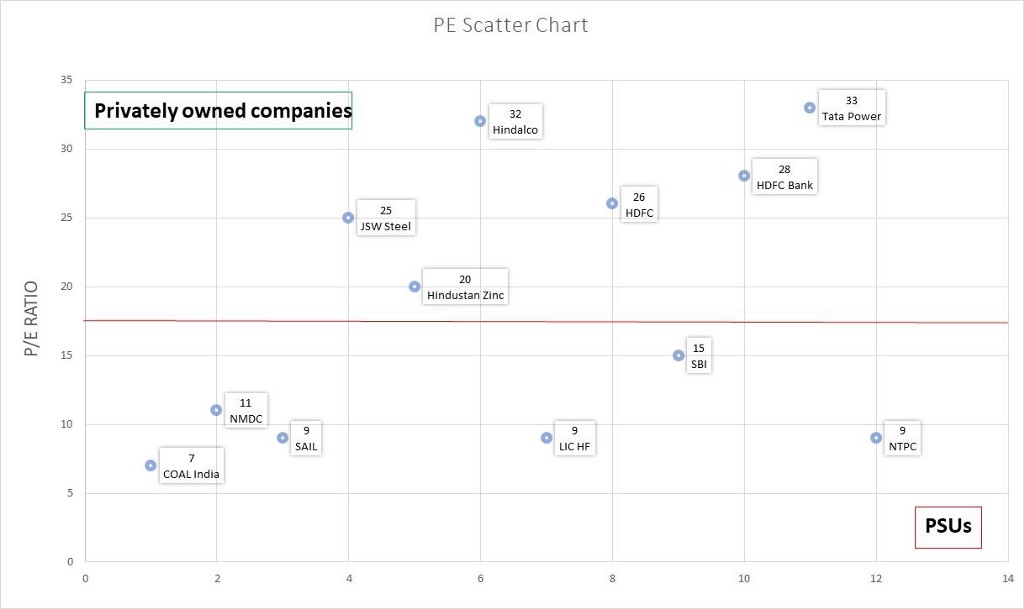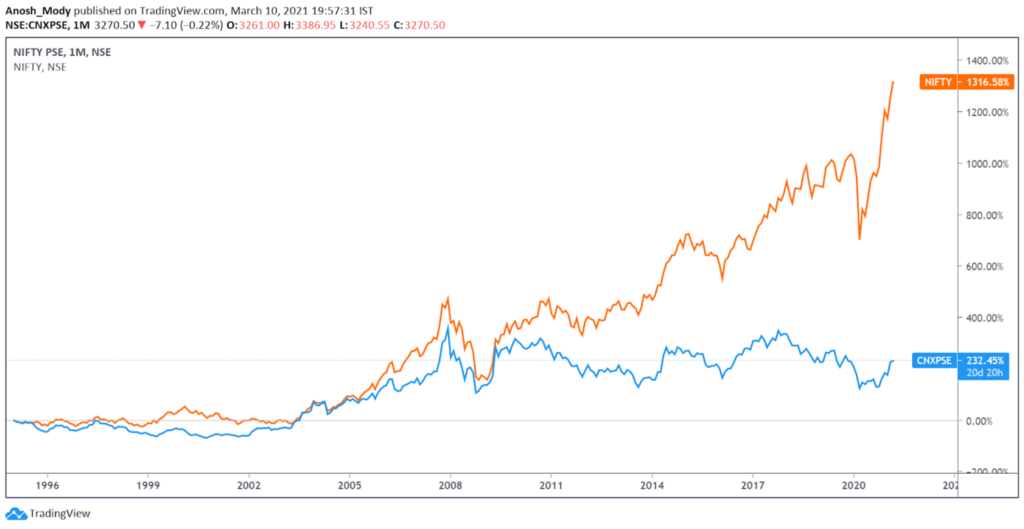What is a Public Sector Undertaking and How is it different from a private entity?
Globally, businesses are run by private enterprises, for example, Chaebols in South Korea and Keiretsu in Japan. A few companies are run by the State, especially in strategic areas like defence, banking, insurance, mining, and oil & gas. These units are called Public Sector Undertaking (PSUs). In India, Tata Steel is an example of a private sector enterprise, while SAIL is a PSU.
According to fundamental analysts, the core nature of a business DOES NOT change just because the owner of the business is different. Simply put, and all things being equal, the intrinsic value of a business (and thus its valuation per share) should be the same whether it is a private enterprise or a PSU, the sole difference being the style of management.
Bharat’s Past glory-the envy of all!
Let me share some perspectives first. Forget going as far as the highly progressive Indus Valley Civilisation (2500 BC to 1900 BC); let us retrace back to the Mauryan Empire of 4th and 3rd Century BC and subsequently the GOLDEN Age under the Gupta Empire (mid to late 3rd Century BC to 543 BC). There is no doubt that India was a dominant global economic power then (Sone ki Chidiya), for which it had to bear the brunt of several invasions.
… this led to 750 yrs of invasions and, thus, its decline!
The Gupta Empire collapsed in the 6th century, and India was again fragmented into numerous regional kingdoms. Successive foreign invasions started from the year 1200 onwards, and after 750 yrs of loot and plunder, left India bereft of its past material riches. In 1947, India gained Independence, but its partition, successive natural calamities, and a broken treasury did not help the noble intentions of the newly-born Republic.
Challenges post-independence
India thus had to embark on a path of rapid industrialisation, and the Five-Year Plan approach was the only option. But how could it achieve this with limited private sector capital? The Government of India had no option but to step in and promote or take over businesses (read Nationalisation). This laid the foundation for the entry of the government into the Indian business world.
PSUs: from 5 to 348 in just 40 yrs…
In 1951, there were just five PSUs in India, but in March 2019, this had increased to 348. PSUs operated across sectors, viz fertilisers, airlines, refineries, shipping etc. These PSUs represented a total investment of Rs. 16.41 lakh cr. as on 31st March 2019, and the total paid-up capital was Rs. 2.76 lakh cr. PSUs collectively earned a whopping Rs. 25.43 lakh cr. during FY 2018–19, and thus command a dominant position in corporate India.
… but PSUs market valuations lag private peers by a huge margin
Several PSUs (also called Maharatnas, Navaratnas or even Mini Ratnas) today command dominant positions in most core sectors and have fundamentals at par with some of their best-run private sector corporates. Yet, ironically, the total worth of listed PSUs (excluding banks) on the Bombay Stock Exchange (BSE) is less than 6.2% of the total market capitalisation. Not all PSUs have strong fundamentals, but many, which are currently loss-making, sit on extensive reserves of prime real estate/property carried in their books at close to zero historical costs. The market seems to be “least interested”.
Given a choice, any investor would prefer to invest in an enterprise where there is “minimal” risk for each unit of potential reward. Despite attractive valuation, the most common push-back from investors towards PSUs is the risk of management continuity, interference by bureaucrats, relatively lower transparency and monopoly-led lethargy.
Right or wrong, this apprehension, unfortunately, determines market valuation. It is not unusual to see a few darling private sector stocks trade even at 100+ price-to-earnings (P/E) ratios while their PSU peers sometimes struggle in the sub-10 range. Likewise, on price-to-book value (P/BV) ratios.
The following graphs show the extreme valuation differentials using a few comparable examples.
They say the market is ALWAYS right, but we beg to differ…
Using pure fundamentals, i.e., the business’s cash flow generating capacity etc., the table below provides a peek into some leading listed PSUs. Observe the 5-yr average ROEs, ROCEs, and key operating margins. Note the near absence of debt in the balance sheets.
Clearly, there is a significant mismatch between fundamentals and market valuation of PSUs.
Above apprehensions apart, we believe the key concern is the high level of state holding. Every year, the government announces a formal divestment target in the budget as it HAS TO RAISE MONEY by selling its shareholdings across PSUs. Like a dangling sword, this thus creates an “overhang” of stake sale, which any investor would hate to deal with on an ongoing basis.
…but, maybe an out-of-the-box solution is right in front of us?
Continue to find out what it is, on Blog by Tickertape.
Disclaimer: Mr. Dick H. Mody, Founder CEO of Ethical Advisers is a SEBI RIA. None of the contents of this article should be considered as investment advice. Mr. Mody and Ethical Advisers shall accept no responsibility of profits or losses occurring out of investment decisions based on the contents of this article. Mr. Mody as well as past and present clients of Ethical Advisers may or may not have open positions in the securities discussed in this article. Please assume that we are biased and have vested interests in publishing the same.
What is a Public Sector Undertaking and How is it different from a private entity? was originally published in Tickertape on Medium, where people are continuing the conversation by highlighting and responding to this story.
Disclaimer: Investing carries risk. This is not financial advice. The above content should not be regarded as an offer, recommendation, or solicitation on acquiring or disposing of any financial products, any associated discussions, comments, or posts by author or other users should not be considered as such either. It is solely for general information purpose only, which does not consider your own investment objectives, financial situations or needs. TTM assumes no responsibility or warranty for the accuracy and completeness of the information, investors should do their own research and may seek professional advice before investing.
- jat·2022-09-21tks for sharing [Like]1Report
- Nglt23·2022-09-21Thks for sharingLikeReport
- Cocoli·2022-09-21Thanks for sharingLikeReport
- aureliapy·2022-09-21thanks for sharingLikeReport
- CKF68·2022-09-21[Money Mafia]LikeReport
- eo1668·2022-09-21ok1Report
- Berrylike·2022-09-21👍LikeReport
- Qing Cai·2022-09-21OkLikeReport
- newtoUS·2022-09-21okLikeReport
- ekwee75·2022-09-21[Happy]LikeReport
- innisfree10·2022-09-21👍LikeReport
- Jazim·2022-09-21okLikeReport
- PunkyBen·2022-09-21GoodLikeReport
- 潘小明·2022-09-21OkLikeReport
- kimmy1234go·2022-09-21GoodLikeReport
- Ericdao·2022-09-21ThanksLikeReport
- Mummysheep·2022-09-21tjsLikeReport
- 我想静一静·2022-09-21[微笑]LikeReport
- JEtrader·2022-09-21🙏LikeReport
- Alancheah·2022-09-21OkLikeReport





